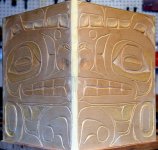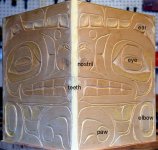Frank Pellow
Member
- Joined
- Jan 16, 2007
- Messages
- 2,743
(post 1 of 5)
Ever since I carved a small totem pole a couple of years ago (see http://festoolownersgroup.com/various-woodworking-crafts-topics/i-am-carving-a-small-totem-pole-this-week/) I have been searching for a course where I could learn how to make and carve a bentwood box.
Last week, I attended a five day course on Bentwood Boxes taught by Steve Brown at the Port Townsend School of Woodworking. The school is located in Port Townsend Washington and that town is among my favourite places in the world. The school is located in the Fort Warden state park, a closed (but very well maintained) military facility. Here is a picture of the main school building (the old powerhouse) which contains two shops:
[attachthumb=#1]
Our course was taught in a nearby auxiliary building:
[attachthumb=#2]
Here is a picture if a portion of the interior of our building with the cedar planks that we were to use for our boxes leaning in the foreground:
[attachthumb=#3]
Steve Brown is a well known artist who lives in nearby Sequim and he specializes in west coast native art.
The sides of a bentwood box are made from a single plank. First three kerfs and a rabbet are cut in the plank, then the plank is soaked in water, then it is steamed, then it is bent into shape. It sounds easy, but it isn’t.
Steve started the course by drawing a handful of various ways that people have chosen to make a kerf and explaining the advantages and disadvantages of each. Here is a drawing of the shape of kerf that Steve prefers to use:
[attachthumb=#4]
Steve starts these kerfs by making three different cuts with a Japanese Azebiki saw then hollows and rounds the kerf with one or more of his home-made bent knives.
Here Steve is demonstrating the use of an Azebiki saw on a scrap piece of wood with Tim Lawson (the director of the Port Townsend Woodworking school) looking on:
[attachthumb=#5]
And, here are several photos of Steve showing the use of a bent knife to complete a kerf:
[attachthumb=#6] [attachthumb=#7] [attachthumb=#8]
The demonstration culminated with Steve soaking, steaming, then bending the wood into a 90 degree angle. This is the technique that should be used to make such a bend:
[attachthumb=#9]
Ever since I carved a small totem pole a couple of years ago (see http://festoolownersgroup.com/various-woodworking-crafts-topics/i-am-carving-a-small-totem-pole-this-week/) I have been searching for a course where I could learn how to make and carve a bentwood box.
Last week, I attended a five day course on Bentwood Boxes taught by Steve Brown at the Port Townsend School of Woodworking. The school is located in Port Townsend Washington and that town is among my favourite places in the world. The school is located in the Fort Warden state park, a closed (but very well maintained) military facility. Here is a picture of the main school building (the old powerhouse) which contains two shops:
[attachthumb=#1]
Our course was taught in a nearby auxiliary building:
[attachthumb=#2]
Here is a picture if a portion of the interior of our building with the cedar planks that we were to use for our boxes leaning in the foreground:
[attachthumb=#3]
Steve Brown is a well known artist who lives in nearby Sequim and he specializes in west coast native art.
The sides of a bentwood box are made from a single plank. First three kerfs and a rabbet are cut in the plank, then the plank is soaked in water, then it is steamed, then it is bent into shape. It sounds easy, but it isn’t.
Steve started the course by drawing a handful of various ways that people have chosen to make a kerf and explaining the advantages and disadvantages of each. Here is a drawing of the shape of kerf that Steve prefers to use:
[attachthumb=#4]
Steve starts these kerfs by making three different cuts with a Japanese Azebiki saw then hollows and rounds the kerf with one or more of his home-made bent knives.
Here Steve is demonstrating the use of an Azebiki saw on a scrap piece of wood with Tim Lawson (the director of the Port Townsend Woodworking school) looking on:
[attachthumb=#5]
And, here are several photos of Steve showing the use of a bent knife to complete a kerf:
[attachthumb=#6] [attachthumb=#7] [attachthumb=#8]
The demonstration culminated with Steve soaking, steaming, then bending the wood into a 90 degree angle. This is the technique that should be used to make such a bend:
[attachthumb=#9]




